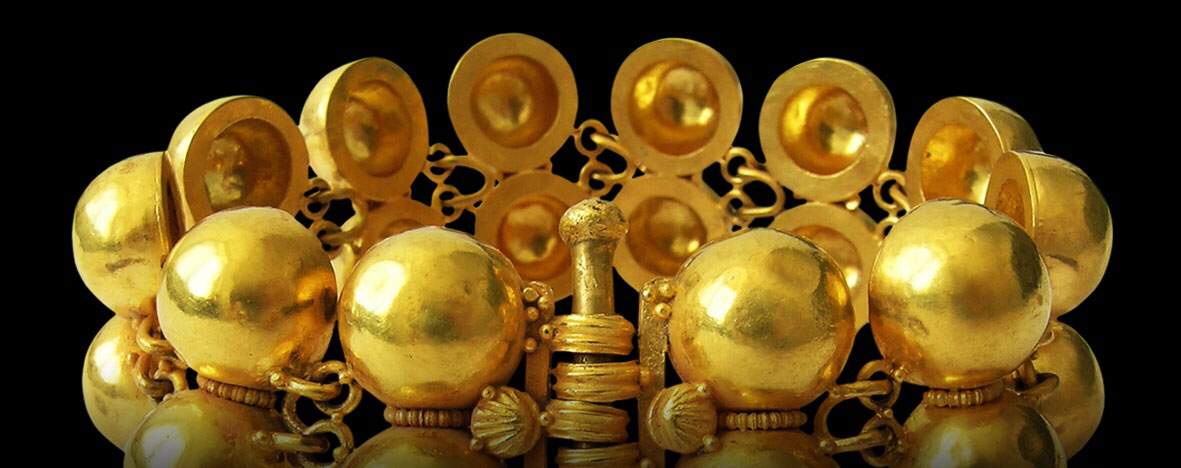Ongoing from December 20, 2018 to September 30, 2019 is the exhibition SplendOri. Luxury in Ornaments at Herculaneum, the first major exhibition of the Herculaneum Archaeological Park within thepark’s Antiquarium, which is also open to public use for the first time for the occasion.
A collection of about 100 jewelry and precious items, unique in terms of the quantity and value of the pieces on display, is presented to the public at the very site of discovery; objects that belonged to the ancient Herculaneumites, some found with the inhabitants in an attempt to bring them to safety from the impending catastrophe of the eruption, others found in the dwellings of the ancient city. Each material on display, harbinger of a story of ancient craftsmanship and manufacture, of rank and symbol, of protection and beauty, as well as of the additional value acquired for having belonged to an inhabitant and having been involved in the tragedy of the city destroyed by the fury of Vesuvius.
SplendOri. Luxury in Ornaments at Herculaneum aims to present to the visitor not only gold jewelry and precious objects, but artifacts of personal and everyday use that appear to us to be uncommon, in terms of workmanship and material, and come from cross contexts to which they will be referred. These contexts of provenance are illustrated in a particular light, that of the declination of luxury, a concept that sums up in itself much more than mere intrinsic and venal value, but is charged with ideological, political, social, cultural, and religious meanings. Ideal domestic settings and stores, objects from the Ancient Beach loaded with symbolic and (not only) economic values, significantly brought with them by the refugees who waited in vain for salvation from the sea, return a cross-section of life with a very precise cut that prefers and enhances this aspect of Herculaneum society in all its facets.
The themes, therefore, of wealth, social economic value and beauty will represent the contents of the exhibition itinerary that finds its home in the Antiquarium of the Archaeological Park, for the first time it is opened to the public at the end of adaptation works, with particular reference to the safety of the finds and environmental conditions, for the most part imposed by the many years that have passed since the now distant date of the testing of this building in 1978.
“Jewelry, coins, gems, furnishings and precious tools for special occasion banquets would be just ’things’ however precious if they were not placed in a narrative,” says Park Director Francesco Sirano, "that evokes their deep social significance and places them in their context of discovery, use and production, if they did not return to the hands and necks of their owners. The materials come from public buildings, the Domus and the workshops of ancient Herculaneum and restore a vivid, complex and happy image of this community. A conspicuous group of finds was found in the course of excavations on the ancient beach, where, as is well known, a large group of inhabitants of the ill-fated city had taken refuge with their belongings and in the clothing befitting the rank of each, waiting for the rescue mission that, at least for them, was unsuccessful. I like to emphasize the loans granted by the MANN and the Pompeii Park, the set of gems and work tools from a jeweler’s workshop and part of the silver treasure from Moregine, a concrete sign of the close cooperation between us in cultural projects."
The exhibition proposes exhibition modes where the visitor is led in an active and participatory way through logics of involvement and participation, which will gradually make him or her a protagonist until the last room where in a dedicated space one can take photos, almost selfies from the past, ideally wearing jewelry and sharing it with the world, thus becoming an ambassador of the Park.
The exhibition SplendOri. Luxury in Ornaments at Herculaneum will also be enlivened with workshop activities organized in collaboration with Tarì and theFrancesco Degni Institute of Higher Education in Torre del Greco, to make visitors participate in the production processes and centuries-old craftsmanship tradition that has settled in Campania.
“The pilot exhibition,” the director further declares, "lays the groundwork for the definitive display in the site’s museum of all the artifacts that from 1927 onward Amedeo Maiuri wanted to remain here and no longer flow into the collections of the National Archaeological Museum in Naples. Thus begins a museographic process that will not remain confined to workshops but will involve the public as an active part of the construction of a museum that guarantees an effective inclusive and participatory knowledge experience. The process stems from the desire to quickly fill a terrible gap in the experience of visiting the site and to interrupt the silence that has lasted for more than 40 years: the public should be able to listen right in the archaeological area to the narrative coming from the countless objects of common use: furnishings, personal ornaments and work tools, decorations, furniture made of various materials, of the incredible amount of organic finds coming directly from the houses, the streets, the canteens of the ancient Herculaneum people."
The exhibition will end on September 30, 2019. Access flows to the exhibition will be managed to ensure the best enjoyment of the experience. For all information you can call +39 081 7777008 send an email to pa-erco@beniculturali.it or visit www.ercolano.beniculturali.it.
 |
| Herculaneum, here is the first major exhibition at the Antiquarium. It is dedicated to the luxury of the ancient Herculaneans |
Warning: the translation into English of the original Italian article was created using automatic tools. We undertake to review all articles, but we do not guarantee the total absence of inaccuracies in the translation due to the program. You can find the original by clicking on the ITA button. If you find any mistake,please contact us.